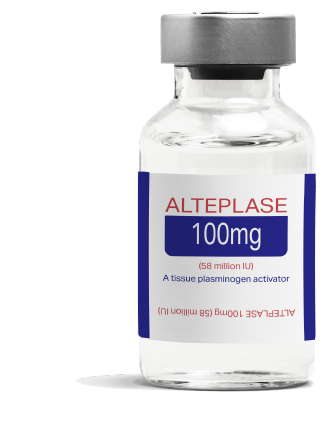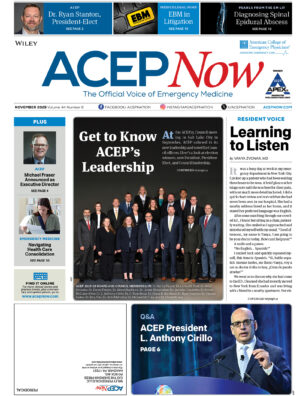If you have trained in emergency medicine in the past 10 years, thrombolysis for acute stroke is more a way of life than an ongoing dispute. We practice in an environment where institutional focus for early treatment of acute stroke reflects various reportable quality measures favoring thrombolysis and rapid treatment even more so. On the other hand, the academic debate rages on, even in the pages of ACEP Now.1
Explore This Issue
ACEP Now: Vol 40 – No 08 – August 2021Independent of this long-simmering tension over the efficacy of thrombolysis for stroke, a handful of other more troublesome ideas have taken root over the past decade. The most important of these is the mantra that thrombolytic therapy is somehow harmless in stroke mimics. This concept is best encapsulated by the title of a 2014 article in Stroke: “t-PA for Stroke Mimics: Continuing to Be Swift Rather Than Delaying Treatment to Be Sure.”2
 The underlying physiological principle promulgated is an assertion no harm from thrombolytic therapy can come to those without underlying cerebral infarction. These claims are supported by citations from observational case series of stroke mimics, in which the authors report the absence of symptomatic intracranial hemorrhage (ICH) following inadvertent thrombolysis. The largest sample, from the Get With The Guidelines Stroke Registry, pools 2,517 stroke mimics and reports a 0.4 percent incidence of symptomatic ICH.3 Thus, erroneously administering thrombolytic therapy to stroke mimics is to be considered undeniably safe.
The underlying physiological principle promulgated is an assertion no harm from thrombolytic therapy can come to those without underlying cerebral infarction. These claims are supported by citations from observational case series of stroke mimics, in which the authors report the absence of symptomatic intracranial hemorrhage (ICH) following inadvertent thrombolysis. The largest sample, from the Get With The Guidelines Stroke Registry, pools 2,517 stroke mimics and reports a 0.4 percent incidence of symptomatic ICH.3 Thus, erroneously administering thrombolytic therapy to stroke mimics is to be considered undeniably safe.
This is undeniably a willful misapplication of these data to practice. Because the rosiest presentation of these data fits with the prevailing narrative, any limitations are conveniently swept away. The fundamental flaw is ascertainment bias (see “Bias 101,” above right), a type of sampling bias in which an analyzed cohort is more likely to include certain patients than others. While evaluating the true frequency and risks to stroke mimics, ascertainment bias is introduced by the criteria used to ultimately differentiate mimics from cerebral ischemia.
Bias in Action
The best evidence demonstrating the effect of ascertainment bias on the diagnosis of stroke mimics comes from the dramatic variation in reported incidence across studies. The neurology literature is replete with estimates of stroke mimic treatment rates as low as 1 to 2 percent and exceeding 20 percent.4 The wide range in estimates relates primarily to the lack of standardized assessment of patients following thrombolysis. In some studies, patients were classified as stroke mimics only if a treating clinician established a conclusive nonstroke diagnosis. Conversely, in other studies, patients systematically underwent MRI to radiographically document the sequelae of an ischemic lesion to confirm stroke. With this rigorous latter approach, rates of thrombolysis in stroke mimics reach 20 percent.
Confirmation bias further influences the low observed rate of ICH in treated mimics. If the prevailing messaging declares ICH after thrombolysis in a stroke mimic to be rare, it becomes tautological that any ICH would be attributed to a true stroke, not a stroke mimic. Thus, few cases of ICH would ever be attributed to thrombolysis of a stroke mimic, particularly the most severe ICH. Furthermore, there would only be biases away from documenting serious complications occurring in a stroke mimic on an individual professional level, from an administrative quality assurance standpoint and a medicolegal view. It is also possible to imagine a financial bias away from seeking out stroke mimics, as the stroke thrombolysis average diagnosis related group reimbursement is nearly triple that of a stroke mimic treated with thrombolysis.5
The Harm of Missing Mimics
The further harm of thrombolysis in stroke mimics involves diagnostic inertia and anchoring bias, in which the true diagnosis is delayed or missed. In a report from Finland describing outcomes of patients assessed during a neurologic emergency department’s drive for door-to-needle times of 20 minutes, 15 percent of their admissions were initially misdiagnosed.6 Of 150 patients with initial misdiagnoses, 70 suffered delays in appropriate treatment, several of whom were specifically harmed by the delay.
Financial harms also result from the treatment of stroke mimics. On a population level, the cost-effectiveness case for thrombolysis in acute stroke is based on the original stroke trials, using outcomes observed in participants with disabling strokes. However, as increasing percentages of patients treated with thrombolysis are stroke mimics, the cost-effectiveness disappears. It is estimated that, at current alteplase vial reimbursement of $8,700, a mimic-treatment rate of roughly 10 percent makes thrombolysis no longer cost-effective on a population level.7 On top of excess treatment of stroke mimics, up to half of patients being treated at some stroke centers have “minor stroke” (National Institutes of Health Stroke Scale <6) or lack disabling neurological deficits.8 Between treating stroke mimics, minor stroke, and nondisabling stroke, the current approach to thrombolysis has completely eroded population-level cost-effectiveness.
Finally, on the individual level, hospitalization following thrombolysis with an acute stroke diagnosis usually generates higher charges than stroke mimic diagnoses.9 These acute stroke charges expose individual patients to potentially greater financial harm, compounded by costs from any long-term medical therapies initiated after stroke. There are further potential harms in the U.S. health care marketplace, as individual insurance coverage becomes potentially more expensive or unobtainable with a serious preexisting medical condition such as ischemic stroke.
There may yet be a debate whether there even remains a debate over the use of thrombolysis for acute stroke. There ought to be no debate, however—our patients deserve better than us burying our heads in the sand regarding the collateral harm of its overuse.
The opinions expressed herein are solely those of Dr. Radecki and do not necessarily reflect those of his employer or academic affiliates.
References
- Milne K. And then there were none. ACEP Now. 2020;39(9):25.
- Guerrero WR, Savitz SI. Tissue-type plasminogen activator for stroke mimics: continuing to be swift rather than delaying treatment to be sure. Stroke. 2013;44(5):1213-1214.
- Ali-Ahmed F, Federspiel JJ, Liang L, et al. Intravenous tissue plasminogen activator in stroke mimics: findings from the get with the guidelines–stroke registry. Circ Cardiovasc Qual Outcomes. 2019;12(8):e005609.
- Zinkstok SM, Engelter ST, Gensicke H, et al. Safety of thrombolysis in stroke mimics: results from a multicenter cohort study. Stroke. 2013;44(4):1080-1084.
- Fee schedules–general information. Centers for Medicare & Medicaid Services website. Available. Accessed July 2, 2021.
- Pihlasviita S, Mattila OS, Ritvonen J, et al. Diagnosing cerebral ischemia with door-to-thrombolysis times below 20 minutes. Neurology. 2018;91(6):e498-e508.
- Liberman AL, Choi H-J, French DD, et al. Is the cost-effectiveness of stroke thrombolysis affected by proportion of stroke mimics? Stroke. 2019;50(2):463-468.
- Hsia AW, Luby ML, Leigh R, et al. Prevalence of imaging targets in patients with minor stroke selected for IV tPA treatment using MRI: the Treatment of Minor Stroke with MRI Evaluation Study (TIMES). Neurology. 2021;96(9):e1301-e1311.
- Goyal N, Male S, Al Wafai A, et al. Cost burden of stroke mimics and transient ischemic attack after intravenous tissue plasminogen activator treatment. J Stroke Cerebrovasc Dis. 2015;24(4):828-833.
Pages: 1 2 3 | Multi-Page






No Responses to “Thrombolysis in Stroke Mimics Is Not Harmless”